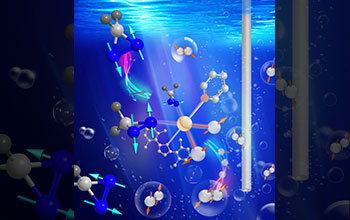Multimedia Gallery
New class of molecular 'lightbulbs' illuminate MRI
Duke University scientists have discovered a new class of inexpensive and long-lived molecular tags that enhance MRI signals by 10,000-fold. To activate the tags, researchers mix them with a newly developed catalyst (center) and a special form of hydrogen (gray), converting them into long-lived magnetic resonance "lightbulbs" that might be used to track disease metabolism in real time.
More about this image
Duke University researchers have taken a major step towards realizing a new form of magnetic resonance imaging that could record biochemical reactions in the body as they happen.
In a published article about the study, the researchers report the discovery of a new class of molecular tags that enhance MRI signals by 10,000-fold and generate detectable signals that last over an hour. The tags are biocompatible and inexpensive to produce, paving the way for widespread use of MRI to monitor metabolic processes of conditions like cancer and heart disease in real time.
"This represents a completely new class of molecules that doesn't look anything at all like what people thought could be made into MRI tags," said Warren S. Warren, the James B. Duke Professor and chair of Physics at Duke and senior author of the study. "We envision it could provide a whole new way to use MRI to learn about the biochemistry of disease."
This research was supported by the U.S. National Science Foundation (grants CHE 1058727, CHE 1363008 and CHE 1416268).
Read more about this research in the NSF News From the Field story New class of molecular 'lightbulbs' illuminate MRI. (Date image taken: unknown; date originally posted to NSF Multimedia Gallery: Jan. 2, 2018)
Credit: Thomas Theis, Duke University
Images and other media in the National Science Foundation Multimedia Gallery are available for use in print and electronic material by NSF employees, members of the media, university staff, teachers and the general public. All media in the gallery are intended for personal, educational and nonprofit/non-commercial use only.
Images credited to the National Science Foundation, a federal agency, are in the public domain. The images were created by employees of the United States Government as part of their official duties or prepared by contractors as "works for hire" for NSF. You may freely use NSF-credited images and, at your discretion, credit NSF with a "Courtesy: National Science Foundation" notation.
Additional information about general usage can be found in Conditions.
Also Available:
Download the high-resolution JPG version of the image. (706.5 KB)
Use your mouse to right-click (Mac users may need to Ctrl-click) the link above and choose the option that will save the file or target to your computer.

